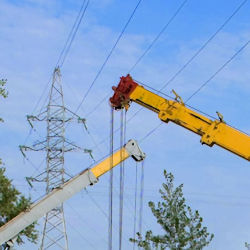Power Line Safety
Danger - High Voltage
Electrocutions caused by a crane, load, or load line contacting a power line have caused numerous fatalities.
Prevent Electrocutions
To prevent such accidents from occurring in the future, the standard contains detailed, systematic procedures that employers must follow when operating cranes near power lines.
These procedures are designed to:
- prevent equipment from making electrical contact with power lines, and
- protect workers in the event that such contact occurs.
NOTE: Special rules apply to work covered by 29 CFR, Subpart V, Power Transmission and Distribution. This course does not cover Subpart V work.
Related Subdivision CC Requirements
- 1926.1408 - Power line safety (up to 350 kV)-equipment operations
- 1926.1409 - Power line safety (more than 350 kV)
- 1926.1410 - Power line safety (all voltages)-equipment operations closer than the Table A zone
Appoint a Project Director
You, along with the utility owner/operator (or registered professional engineer) and all other employers involved in the work, must identify one person who will direct the implementation of the procedures.
That person must have the authority to stop work at any time to ensure safety.
Reconsider Your Plan if a Problem Arises
The danger of operating a crane close to a power line cannot be overemphasized. Procedures that may appear adequate at the beginning of a job may not be adequate in practice. For example, if electricity arcs from the line to the equipment, whatever precautions are being taken is not sufficient.
Knowledge Check Choose the best answer for the question.
4-1. To prevent future accidents, OSHA's power line safety procedures have been designed to _____.
- prevent equipment from making electrical contact with power lines
- designate competent and qualified persons to over see crane operations
You forgot to answer the question!

